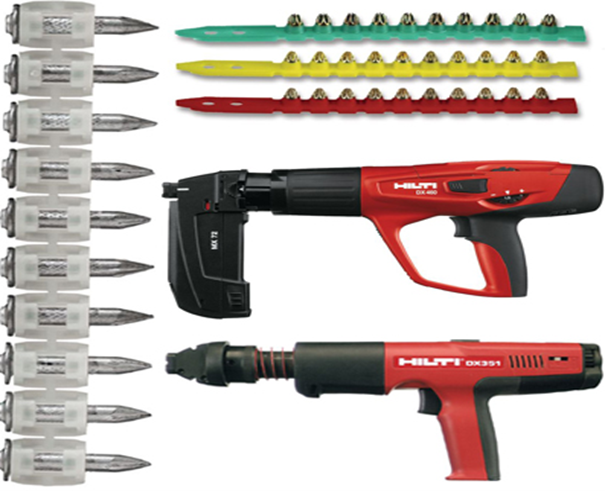A powder-actuated tool (PAT) is a tool that gets its power from an explosive charge. The tool uses the expanding gas from the explosion to drive a fastener into materials such as masonry, concrete, steel, and other hard surfaces. Only trained, competent, and authorized persons are permitted to operate a powder-actuated tool (also known as explosive-actuated tools). The training should be in accordance with the specific tool manufacturer’s criteria. A card verifying training should be issued to the authorized person after training is completed. Unauthorized or improper use of a powder-actuated tool could result in a serious injury or a death. Even if you have been trained and authorized to use a PAT, test the tool each day before loading using the testing method recommended by the manufacturer. Make sure the muzzle end of the tool has a protective shield centered perpendicular to the barrel to stop flying fragments. (The tool should be designed not to fire unless this shield is in place.) If you find that the tool is damaged or defective, tag it as such and remove it from service immediately.
A powder-actuated tool operates like a loaded gun so it should be handled with the same respect and safety precautions. When a job calls for a PAT, be sure to choose the correct cartridge for the fastener being used then load the tool just before you intend to use it, keeping your hands clear of the open barrel end. Never carry a loaded PAT from job to job and don’t leave it unattended. As with a gun, always keep the tool pointed in a safe direction; never point it anyone.
When using a PAT, be sure to wear the appropriate personal protection equipment including safety glasses or a face shield and hearing protection. A powder-actuated tool must be held firmly against and perpendicular to the surface into which it’s driving the fastener. Securely brace yourself when using PATs on ladders or scaffolds to maintain good balance.
Only shoot into a surface you’re certain will safely contain the fastener; never shoot into a blind surface. Take the time to check the other side of your surface to ensure that no one is in the path of the fastener. When driving fasteners into materials like brick or concrete, stay at least 3 inches away from an edge or corner. With steel, the fastener must not come any closer than one-half inch from a corner or edge. Keep bystanders away from the work area. Shields for protecting workers against a possible ricochet may be necessary in the working area. Never drive fasteners into very hard or brittle materials like cast iron, glass blocks, glazed tile or other material that the fastener could shatter, ricochet off or pass through. And don’t drive fasteners into a spalled area or where a previous fastening was unsuccessful.
Be especially careful that you don’t use a powder-actuated tool in flammable, combustible or explosive environments.
Rules for disposal of Hilti cartridges
- A 5-gallon bucket or similar container partially filled with water will be placed at each jobsite to dispose of all Hilti cartridges daily. The bucket will be labeled “Hilti cartridges Only”
- All fully spent/fired cartridges will be disposed of in normal job site trash.
- All partially spent/cartridges should be shot into the tool to ensure they are truly misfires.
- All shot that has been re-fired and still has not been spent should be returned to the water filled collection bucket/container labeled “Hilti cartridges only”
- All mis-fired cartridges will be collected on a monthly basis by the Safety manager or Foreman and will be disposed of by a hazardous waste management company determined by your specific site. Please check with your site GC for their preferred method of disposing of misfired cartridges. If you have questions, please contact your regional Safety Manager or the Safety Director.
*** If a tool continues to have misfired cartridges. Please ensure that it is cleaned and inspected for damage. If the tool continues to misfire, please take it out of service.

